
San Francisco Sourdough Experiments. Results Need Explanation.
Last week I made San Francisco Sourdough, and learned a lot. I decided to try it again this weekend with some variations relating to flour mix, dough handling, retardation time and loaf shape.
I again used the formula in Peter Reinhart’s Crust and Crumb, and I again used primarily Bob’s Red Mill bread flour. But this time, instead of 100% bread flour I used about 9% dark rye flour and about 11% whole wheat flour. I used the rye and whole wheat in each of the three mixes: the liquid starter, the firm starter and the main dough. I did not adjust the hydration (64%).
My other departures from the C&C formula were:
- Though the formula calls for kneading the dough, then letting it sit unmolested in a bowl for four hours, I gave it a four-way letterfold every hour. The dough was firmer (less slack) this time, compared to last weekend when I did no folds.
- I followed the formula’s specifications for ripening and then retarding the two starters, but I decided to test the effects of retardation after proofing and to test the attributes of different loaf shapes using this formula. I scaled the dough for 3 mini-baguettes of 250 grams each and a boule and a batard of 615 grams each. The baguettes I baked as soon as they were proofed; the larger loaves were put in the fridge overnight after proofing 3 hours as in the formula.
I should also mention that I proofed the baguettes and the batard on linen couche, and the boule in a linen-lined basket. I did not spray oil on the loaves at the beginning of proofing as Reinhart specifies. The baguettes were covered with a fold of couche fabric and a tea towel over that.
Here’s the fermented dough after a 3 ½ hour rise.
Here’s the proofing loaves.
The baguettes baked at 450 on a stone with steam for 10 minutes, then without steam at the same temperature for another 10 minutes. Then I left them to sit on the stone with the oven off and the door ajar for another 10 minutes. The internal temperature was 209F. They’re really pretty to look at.
The crust is darkish, and very hard. Indeed, it is positively tough, as in hard to bite through.
The crumb is very good tasting and nicely chewy, not what I’d call tough. Not a very open crumb, but not really dense.
It was a really good thing I had delicious Chicken Cacciatore to dip the bread in to moisten it (the bread made a fine mop). Thanks for the recipe, David.
So, you experienced bakers, what caused the rock hard crust this time?
- · Increased gluten strength from the folds during ferment?
- · Baguette shaping?
- · Baguettes getting too much air (not sealed in plastic) during proofing?
- · Too low hydration?
- · Too bold a bake or too much time drying on the stone?
Any help would be appreciated. The boule and batard just came out of the oven, and I’ll report results later.
Thanks.
Glenn
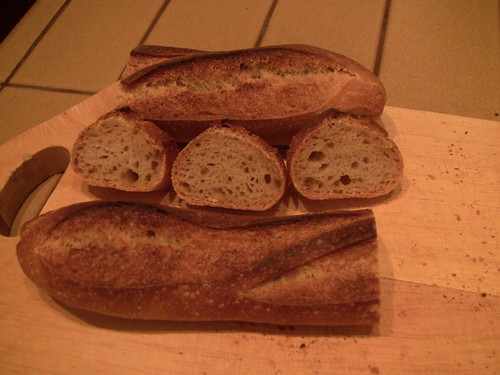
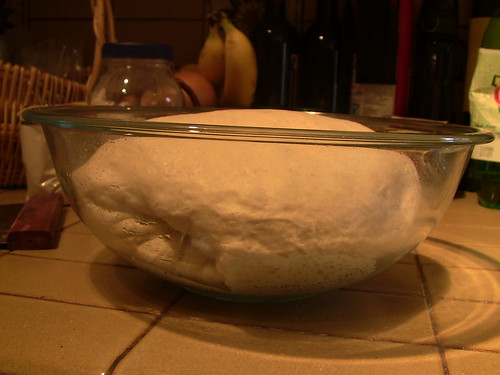

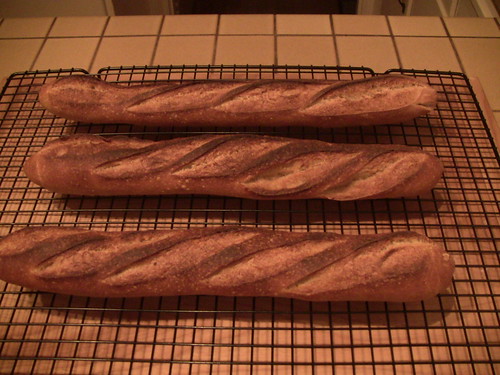
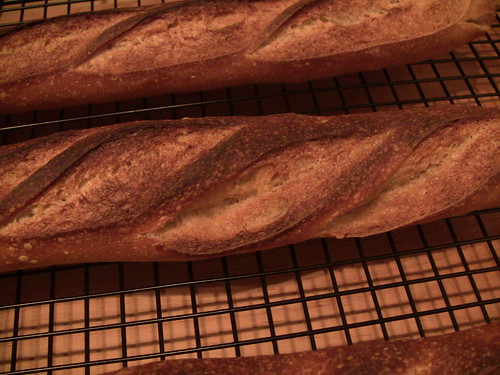
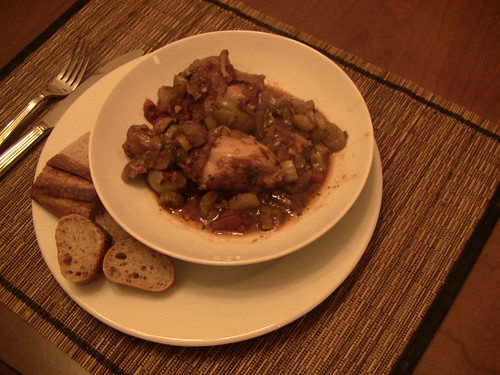


Comments
Hi, Glenn.
Yummy-looking bread and pollo!
The short (and probably un-helpful) answer to your hard crust question is that the C&C SF SD formula makes wonderful bread, but it was never intended for baguettes. Here's a (no doubt incomplete) list of reasons why what you did did what it did:
* Soudough baguettes typically have a chewier crust than those made with yeasted dough. It has to do with the crust hanging onto water more strongly, I think.
* Your 20% whole grains, while no doubt giving a better flavor, also made a drier dough and harder crust. (The "effective hydration" would be lower.)
* You used a white flour with higher gluten than AP. All else being equal, that will give you a thicker, harder crust. (This type of flour gives a chewier SD crumb which you may want in a SF SD, but it's not so wonderful for baguettes where there is a lot more crust compared to crumb.) The S&Fs are appropriate to develop the gluten to give you the chewiness and open crumb you want in a SF SD. If you don't want chewy in your baguettes, why use that flour?
* I think your baking time and temperature were entirely appropriate for baguettes. You just aren't going to get a thin, crisp crust with the dough you used.
Now, there are things you could have done to make the crust come out softer - include some potato flour in the dough, brush the crust with milk, stick the still-warm loaves in plastic bags. But, I don't think that's what you want.
The best solution is to use a different formula for SD baguettes than you would use for a SF SD boule. That's my opinion, anyway.
David
The SFSD boule and batard are out of the oven and cooled, and the boule is sliced and sampled.
The texture of crust and crumb is much superior to the baguettes. The crust is somewhat bite-resistant but not tough. And the volume of springy chewy crumb is better. I think David hit the nail on the nose. SFSD is just not a good formula for baguettes, if you are trying to make something edible (could be considered perfect for a cudgel).
I used the same flour this week as last, the main difference being the substitution of 20% whole grains (with no added water). You can see the crumb is not as open as the loaves I baked last week, pictured below. Interesting profile difference, too. More upward spring and less spread from tighter sheath from the S&Fs?
The flavor of today's multiply retarded loaves is considerably sourer than last week's less retarded bake. The whole grains and increased retardation make really good flavor additions.
But enough about bread. Tasha insists I've been petting dough too much and her not enough.
Glenn
and yes, as David pointed out, you're using a high gluten flour which is never going to give you the crisp, snappy crust so characteristic of a baguette. Hamelman and MacGuire claim that anything flour north of 12% protein is a bad choice for baguettes.
But nice shaping and scoring I see.
Larry
Thanks, Wally. I'm now getting pretty consistent at shaping and scoring baguettes well. Even if these tough suckers end up as crumbs, I got more practice in. Not a total loss. And, as I noted, the bigger loaves are real good eating.
Glenn
Illuminaing...And David's comments really help fill in the gaps!
Very useful!
Jay
Glenn
The day after the big loaves were baked, the bread has improved. It is sour and complex in flavor, and the crumb is still moist. I like this bread!
Glenn
The C&C SF SD won the James Beard Award for Peter Reinhart, as you know. It's definitely a wonderful bread. It pulls out all the stops. The SF SD in BBA is a simplified version, and it's just not as good, in my opinion.
BTW, if you froze some of the hard-crusted baguettes, use them sliced thinish for French toast. The frying will transform the crust into crispiness you may enjoy. You could also slice them thin and toast them brushed with olive oil in the oven. Use them for crostini.
David